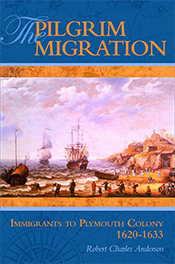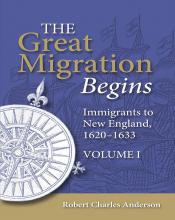RICHARD MORE
ORIGIN: Shipton, Shropshire
MIGRATION: 1620 on Mayflower
FIRST RESIDENCE: Plymouth
REMOVES: Salem 1637
RETURN TRIPS: To England after 1627 and returned June or July 1635 in the Blessing; travelled to Virginia or Maryland in the early 1640s [NGSQ 62:168]
OCCUPATION: Mariner. In November 1674 Thomas Smith deposed that he was aboard the ship Friendship of Salem, Richard Moore, master [EQC 5:444].
Tavernkeeper. "Capt. Richard More" was licensed to keep an ordinary and to sell beer and cider, but not wine or liquors, for a year, September 1674 [EQC 5:400].
CHURCH MEMBERSHIP: Salem 27 February 1642/3 [SChR 11].
FREEMAN: 28 February 1642/3 [EQC 1:50]. EDUCATION: He signed his name to deeds but Christian made her mark.
OFFICES: Perhaps some of the considerable petit jury and grand jury service in Essex County pertained to this Richard More, although there was another man of this name in Lynn contemporaneously [EQC 3:154, 4:292].
ESTATE: In the 1627 Plymouth division of cattle Richard More was the fourth person in the fifth company headed by William Brewster [PCR 12:10].
On 1 November 1637 "Richard Moore of Ducksborrow, yeoman," sold all his property in Duxbury to Abraham Blush [PCR 12:22-23].
On 3 October [1649] James Hyndes of Salem sold to Richard Moore one dwelling house on the south river side with three quarters of an acre adjoining and ten acres of upland in the south field [ELR 1: 16]. On 20 September 1659 Richard Moore of Salem, mariner, mortgaged to Henry Shrimpton of Boston one dwelling house with three quarters of an acre, with the yard, warehouse and stable in Salem [ELR 1:69]. On 13 September 1655 John Horne of Salem sold to Richard Moore of Salem one dwelling house and an acre of land [ELR 2:82A].
On 7 July 1662, "Mr. Richard Moore and Mary Chichester, wife of William, came into court and acknowledged their free act and deed in exchanging a piece of land of about seven poles that lay on the north side of said Marie's ground for so much lying on the east side of said ground, as the fence now stands" [EQC 2:432].
On 11 July 1664 Henry Bartholomew of Salem, with the consent of his wife Eliza, sold to Richard More of Salem a dwelling house and an acre of land in Salem [ELR 2:82A]. On 20 January 1667[/8] Richard More of Salem, mariner, sold to Edward Grove of Salem, sailmaker, half an acre "which More has by an execution against John Prescott" [ELR 3:27]. On 10 January 1670[/l] Richard More of Salem, mariner, and Christian his wife, sold to Thomas Pitman of Marblehead, husbandman, ten acres in Marblehead [ELR 3:107]. On 21 September 1658 Richard Moore of Salem, mariner, sold to William Flint of Salem, husbandman, ten acres in the south field [ELR 3:127]. On 27 September 1671 Richard Moore Sr. of Salem, mariner, sold to William Browne Jr. of Salem, half an acre in Salem [ELR 3:127 and re-recorded 3:174].
On 30 August 1673, "Richard More of Salem, mariner," with the consent of Christian his wife, sold his rights as a purchaser at Swansea to Samuel Shrimpton of Boston [PCLR 3:303].
On 10 June 1675 Richard More of Salem for "natural affection" deeded to "Caleb More & Richard More my sons and my daughters Susanna & Christian More ... my dwelling house in Salem where I now live with all out houses etc. and all moveables quick and dead" [ELR 4:114].
On 4 June 1684 Richard More Sr. of Salem deeded for natural affection "more especially for & in consideration of marriage betwixt him the said Samuel Dutch and my daughter Susannah his now wife" land in Salem where Samuel Dutch's house then stood and a quarter of an acre where a highway ran through part of More's orchard [ELR 6:123]. .
On 9 October 1687 Richard More Sr. of Salem, mariner, sold to John Higginson Jr. of Salem, merchant, a parcel of flats and wharf land in Salem south of "my now dwelling house" [ELR 8:9]. On 17 December 1687 Richard More of Salem, mariner, mortgaged to Mr. Phillip Cromwell of Salem, slaughterer, a small parcel of land in Salem containing the out kitchen and leanto [ELR 8:15]. On 15 May 1688 Richard More Sr. of Salem, mariner, sold to William Browne Esq. and Mr. Benjamin Browne, both of Salem, "my homestead which I am now possessed of ... in Salem ... excepting the piece of land I mortgaged to Philip Cromwell" [ELR 8:85].
On 14 August 1688 Richard More Sr. and Richard More Jr., both of Salem, mariners, sold to Peter Osgood of Salem, tanner, sixty poles of ground in Salem, part of the houselot [ELR 8:93].
On 10 July 1688 Richard More Sr. of Salem, mariner, deeded to "my son Richard More Jr." part of "my dwelling house called by new room or long room with the garden enclosed and the cellar under it" [ELR 8:95]. On 10 May 1690 Richard More of Salem deeded the land he had mortgaged in 1687 to Philip Cromwell, slaughterer [ELR 8:150].
BIRTH: Baptized Shipton, Shropshire, 13 November 1614, the repudiated son of Samuel and Catherine Moore of Larden [MD 22:77).
DEATH: Salem between 19 March 1693/4 and 20 April 1696 [MD 22:49, 78], "aged eighty-four years" [MD 22:49].
MARRIAGE: (1) Plymouth 20 October 1636 Christian Hunter [PCR 1:45]. She was born say 1615 and died Salem 18 March 1676, aged sixty [MD 3:198]. She was twenty years old when she came on the Blessing in 1635 [TAG 40:77].
(2) By 1678 Jane (_) Crumpton, widow of Samuel Crumpton who was slain at Muddy Brook Bridge on 18 September 1675, in the company of THOMAS LOTHROP {1633, Salem} [Badge 137; GMB 2:1201-6]. On 23 May 1678 "Richard More, as husband of the relict of Samuel Crumpton," sued Christopher Lattimore for debt [EQC 7:111]. She died at Salem on 8 October 1686, "aged 55 years" [MD 3:198].
CHILDREN:
With first wife
- SAMUEL, bp. 6 March 1641/2 [SChR 18]; living 1651 [Bradford 444] but no further record.
- THOMAS, bp. 6 March 1641/2 [SChR 18]; living 1651 [Bradford 444] but no further record.
- CALEB, bp. 31 March 1644 (SChR 20]; d. Salem 4 January 1678/9, aged thirty-four years [MD 3:109]; unm.
- JOSHUA, bp. 3 May 1646 [SChR 21]; living 1651 [Bradford 444] but no further record.
- RICHARD, bp. 2 January 1647/8 [SChR 21]; m. by 1673 Sarah __ [MD 3:199].
- SUSANNA, bp. 12 May 1650 [SChR 22]; m. (1) say 1675 Samuel Dutch (her father witnessed her bond as administratrix of Samuel's estate 19 March 1694 [MD 22:77]); m. (2) by 1696 as his second wife Richard Hutton [EPR Case #8426]; m. (3) (int.) Wenham 11 April 1714 John Knowlton. (The best account of the Dutch family was published by Walter Goodwin Davis in 1947 [Phoebe Tilton Anc 87-107].)
- CHRISTIAN, bp. 5 September 1652 [SChR 23]; m. Salem 31 August 1676 Joshua Conant [MD 3:200].
COMMENTS: In his accounting of the Mayflower passengers, Bradford included in the household of William Brewster "a boy [that] was put to him called Richard More" [Bradford 441]. In 1651, Bradford wrote that "Richard More's brother died the first winter, but he is married and hath four or five children, all living" [Bradford 444]. Richard More was one of four children of Samuel and Katherine More, whose bitter divorce made the Mayflower voyage a welcome answer to the problem of placement of their unwanted children. Sir Anthony Richard Wagner has provided us with the first and most accurate account of the English background of Richard More and his siblings [NEHGR 114:163-68 and 124:86-87]. More recently Donald Harris has presented much of this same material, placing it in historical context, but adding little about More himself [MD 43:123-132, 44:11-20, 109-118].
A "Richard More of Salem in New England" married on 23 October 1645 at St Dunstans, Stepney, Middlesex, at a time when Richard More of Salem was certainly married. Unless we are prepared to accept Richard More of Salem as a bigamist, there must have been, at least for a brief time, two Richard Mores in Salem.
The bell taken at Port Royal, Nova Scotia, was brought to Salem "in Capt. Moor's Ketch."
At court January 1641 John Stacy sued Richard More for killing his swine [EQC 1 :30]. On 1 January 1645 Thomas Tuck testified that Richard Moore "made a well upon the common for his own use the last summer, being very dry and water scarce upon the neck. Tuck hired a cow, which came to drink at the well, and the water being very low the cow broke her neck" [EQC 1:93].
On 29 June 1654, the administrators of the estate of Richard Hollingworth acknowledged a judgment to Capt. Traske and another to Rich[ard] Moore [EQC 1 :359].
In June 1661 when William Shakkerley, master of the bark Hopewell, complained that it was insufficient for a voyage to Newfoundland, the court commissioned Richard More, master, and others to examine it [EQC 2:313]. On 30 September 1665 Robert Starr deeded to Capt. Richard More and Mr. Philip Cromwell as guardians to "my three children Robert, Richard and Susanna" a house "given to me by my father-in-law Richard Hollingsworth as a portion with my wife ... for the use and benefit of my three children" [ELR 3:139].
For the 27 June 1665 court, Richard More, aged "about fifty years," deposed in a case between Symond Crosby and Henry Roads [EQC 3:256]. On 15 January 1665[/6], Bartholomew Roes Jr. at "Charlestown in Carolina" authorized payment to "Capt. Richard Moore" of 673 pounds of "good Muschovadee Sugar" [ELR 3: 101]. On 24 January 1666[/7], Richard More executed a bill of lading for the ship Swan carrying tobacco on account of Col. Augustine Warner of Virginia [ELR 3:5]. On 3 March 1668/9, Richard More deposed regarding the law and customs for the entry of vessels into Maryland [SJC #907]. On 3 March 1668/9 Richard More deposed regarding the law and customs for the entry of vessels into Maryland [SJC #907].
BIBLIOGRAPHIC NOTE: In 1997 the Five Generations Project of the General Society of Mayflower Descendants published a revised version of the family and descendants of Richard More, compiled by Robert Moody Sherman, Robert S. Wakefield and Lydia Dow Finlay [MF 15: 151-87]. In 1901 George Ernest Bowman published several depositions given by Richard More late in his life, regarding events that had happened in his early New England years; this article also included photographs and transcriptions of a number of early tombstones [MD 3:193-201].
In 2002 David Lindsay published Mayflower Bastard: A Stranger Among the Pilgrims (New York 2002), a biography of Richard More, which takes great liberties with the available evidence [TAG 77:318-19]. .

The Pilgrim Migration: Immigrants to Plymouth Colony 1620-1633
Buy the print edition of The Pilgrim Migration: Immigrants to Plymouth Colony 1620-1633.

The Great Migration Begins: Immigrants to New England 1620-1633
Buy the print edition of The Great Migration Begins: Immigrants to N.E. 1620-1633 Vols I-III.
Become an American Ancestors.org member to access this biography and over 40,000 more records in the searchable online database of The Great Migration Begins: Immigrants to N.E. 1620-1633 Vols I-III.
This authoritative work by Robert Charles Anderson identifies and describes all Europeans who settled in New England prior to the end of 1633. Each individual or family entry includes (when known) the port or country of origin; when and on what ship they arrived in New England; the earliest known record of the individual or family; their first and subsequent residences; return trips to their country of origin; marriages, births, and deaths; and other important family relationships. This work is available in print and database form on AmericanAncestors.org.




